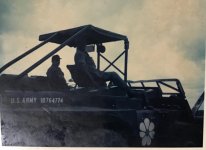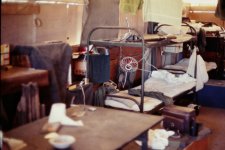- Joined
- Apr 21, 2021
- Messages
- 4,951
- Reaction score
- 8,452
 Our unit had a Spc.5 assigned that was “ different”. Could never figure out how he made Spc. 5 but one day he thought he would help everyone. He “ borrowed” our RT forklift , drove in the hard stand lot of the PX, forked up a Whole Pallet of Bud and drove out. Later we heard the LN’s at the gate were yelling and running after him naturally yelling “ Numba 10 GI”. Anyway he drove back to our shop with the pallet of Bud and asked our Motor Sgt. where he wanted it. Motor Sgt said, “ in the shop” so there was a whole pallet of Bud sitting there for maybe 30 minutes. Shortly the MP’s showed up with the LN in charge of the PX gate. Naturally they went straight to Motor Sgt. asking who had used our RT. Now most thought there are so many RT’s around how did they know it was us? Problem was, few years eariler someone painted a Large Daisy on the fuel tank, we all just said , “ go get Daisy and take 105 tubes to the Ord. shop, no one thought about it. Anyway the MP’s asked the LN’s at the gate, they all said “ big flower”, MP’s knew right away it was us, end of investigation.BTW, we Never got any Bud, only Carling Black Label, Schlitz and some others I don’t remember. We did get bottles of San Miguel which was pretty good chilled in a reffer.
Our unit had a Spc.5 assigned that was “ different”. Could never figure out how he made Spc. 5 but one day he thought he would help everyone. He “ borrowed” our RT forklift , drove in the hard stand lot of the PX, forked up a Whole Pallet of Bud and drove out. Later we heard the LN’s at the gate were yelling and running after him naturally yelling “ Numba 10 GI”. Anyway he drove back to our shop with the pallet of Bud and asked our Motor Sgt. where he wanted it. Motor Sgt said, “ in the shop” so there was a whole pallet of Bud sitting there for maybe 30 minutes. Shortly the MP’s showed up with the LN in charge of the PX gate. Naturally they went straight to Motor Sgt. asking who had used our RT. Now most thought there are so many RT’s around how did they know it was us? Problem was, few years eariler someone painted a Large Daisy on the fuel tank, we all just said , “ go get Daisy and take 105 tubes to the Ord. shop, no one thought about it. Anyway the MP’s asked the LN’s at the gate, they all said “ big flower”, MP’s knew right away it was us, end of investigation.BTW, we Never got any Bud, only Carling Black Label, Schlitz and some others I don’t remember. We did get bottles of San Miguel which was pretty good chilled in a reffer.
Last edited:






